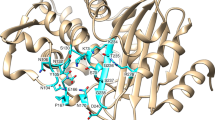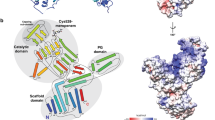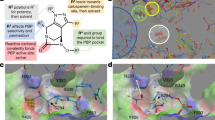Abstract
The β-lactam antibiotics kill bacteria by inhibiting a set of penicillin-binding proteins (PBPs) that catalyse the final stages of peptidoglycan synthesis1,2. In some bacteria the development of intrinsic resistance to β-lactam antibiotics by the reduction in the affinity of PBPs causes serious clinical problems1,3–11. The introduction of β-lactam antibiotics that are resistant to hydrolysis by β-lactamases may also result in the emergence of intrinsic resistance among the Enterobacteriaceae1. The clinical problems that would arise from the emergence of resistant PBPs in enterobacteria have led us to examine the ease with which Escherichia coli can gain resistance to β-lactams by the production of altered PBPs. The development of resistant PBPs also provides an interesting example of enzyme evolution, since it requires a subtle re-modelling of the enzyme active centre so that it retains affinity for its peptide substrate but excludes the structurally analogous2,12,13 β-lactam antibiotics. We show here that only four amino-acid substitutions need to be introduced into PBP 3 of E. coli to produce a strain possessing substantial levels of resistance to a wide variety of cephalosporins. We also show that transfer of the gene encoding the resistant PBP 3 from the chromosome to a plasmid could result in the spread of intrinsic resistance not only to other strains of E. coli but also to other enterobacterial species.
This is a preview of subscription content, access via your institution
Access options
Subscribe to this journal
Receive 51 print issues and online access
$199.00 per year
only $3.90 per issue
Buy this article
- Purchase on Springer Link
- Instant access to full article PDF
Prices may be subject to local taxes which are calculated during checkout
Similar content being viewed by others
References
Spratt, B. G. J. gen. Microbiol. 129, 1247–1260 (1983).
Waxman, D. J. & Strominger, J. L. A. Rev. Biochem. 52, 825–870 (1983).
Reynolds, P. E. Br. med. Bull. 40, 3–10 (1984).
Parr, T. R. & Bryan, L. E. in Antimicrobial Drug Resistance (ed. Bryan, L. E.) 81–111 (Academic, New York, 1984).
Brown, F. J. & Reynolds, P. E. FEBS Lett. 122, 275–278 (1980).
Hayes, M. V., Curtis, N. A. C., Wyke, A. & Ward, J. B. FEMS Microbiol. Lett. 10, 119–122 (1981).
Hartman, B. J. & Tomasz, A. J. Bact. 158, 513–516 (1984).
Rossi, L., Tonin, E., Cheng, Y. R. & Fontana, R. Antimicrob. Ag. Chemother. 27, 828–831 (1985).
Zighelboim, S. & Tomasz, A. Antimicrob. Ag. Chemother. 17, 434–442 (1980).
Parr, T. R. & Bryan, L. E. Antimicrob. Ag. Chemother. 25, 747–753 (1984).
Dougherty, T.J., Koller, A.E. & Tomasz, A. Antimicrob. Ag. Chemother. 18, 730–737 (1980).
Tipper, D. J. & Strominger, J. L. Proc. natn. Acad. Sci. U.S.A. 54, 1133–1141 (1965).
Spratt, B. G. Nature 274, 713–715 (1978).
Spratt, B. G. Proc. natn. Acad. Sci. U.S.A. 72, 2999–3003 (1975).
Sykes, R. B. et al. Nature 291, 489–491 (1981).
Hedge, P. J. & Spratt, B. G. Eur. J. Biochem. 151, 111–121 (1985).
Harder, H. J., Nikaido, H. & Matsuhashi, M. Antimicrob. Ag. Chemother. 20, 549–552 (1981).
Jaurin, B., Grundström, T. & Normark, S. EMBO J. 1, 875–881 (1982).
Suzuki, H., Nishimura, Y. & Hirota, Y. Proc. natn. Acad. Sci. U.S.A. 75, 664–668 (1978).
Miller, J. H. Experiments in Molecular Genetics (Cold Spring Harbor Laboratory, New York, 1972).
Coulondre, C. & Miller, J. H. J. molec. Biol. 117, 52–567 (1977).
Hedge, P. J. & Spratt, B. G. FEBS Lett. 176, 179–184 (1984).
Messing, J. & Vieira, J. Gene 19, 269–276 (1982).
Biggin, M. D., Gibson, T. J. & Hong, G. F. Proc. natn. Acad. Sci. U.S.A. 80, 3963–3965 (1983).
Nakamura, M., Maruyama, I. N., Soma, M., Kato, J.-I., Suzuki, H. & Hirota, Y. Molec. gen. Genet. 191, 1–9 (1983).
Spratt, B. G. Eur. J. Biochem. 72, 341–352 (1977).
Author information
Authors and Affiliations
Rights and permissions
About this article
Cite this article
Hedge, P., Spratt, B. Resistance to β-lactam antibiotics by re-modelling the active site of an E. coli penicillin-binding protein. Nature 318, 478–480 (1985). https://doi.org/10.1038/318478a0
Received:
Accepted:
Issue Date:
DOI: https://doi.org/10.1038/318478a0
This article is cited by
-
Cephalosporin resistance, tolerance, and approaches to improve their activities
The Journal of Antibiotics (2024)
-
Identification and characterisation of emerging fish pathogens Aeromonas veronii and Aeromonas hydrophila isolated from naturally infected Channa punctata
Antonie van Leeuwenhoek (2024)
-
Hybrid penicillin-binding proteins in penicillin-resistant strains of Neisseria gonorrhoeae
Nature (1988)
Comments
By submitting a comment you agree to abide by our Terms and Community Guidelines. If you find something abusive or that does not comply with our terms or guidelines please flag it as inappropriate.



